From The Soho News (August 4, 1981), very slightly tweaked on January 27, 2010. –J.R.
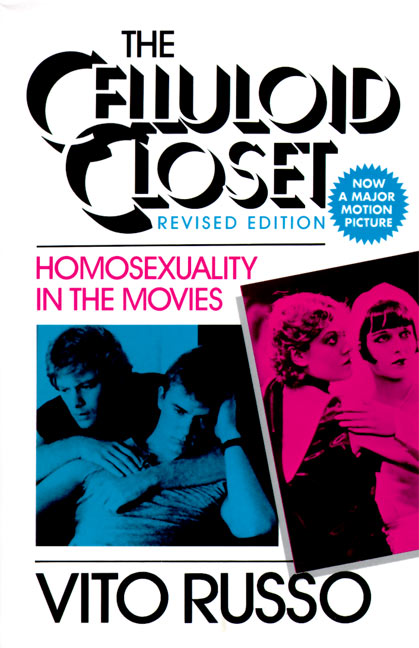
The Celluloid Closet:
Homosexuality in the Movies
By Vito Russo
Harper Colophon Books, $7.95

Want to read the first comprehensive study in English of homosexuality in the movies? Go hunt up Parker Tyler’s Screening the Sexes (1972). Prefer a more theoretical and political, less coterie-oriented approach? Try Richard Dyer’s first-rate Gays and Film (1975), which includes Caroline Sheldon on lesbians, Dyer on stereotyping, and Jack Babuscio on camp. Like something even more up to date, dealing with the “textual incoherence” of recent Hollywood movies like Cruising and Looking for Mr. Goodbar from a gay lib perspective? Check out Robin Wood’s interesting and fruitful article (no pun intended) in the current issue of Movie.
Where does this leave Vito Russo’s serious and ambitious The Celluloid Closet — which incidentally bears the same subtitle as Tyler’s book? Not so much in the lurch as the above list may imply. As the best researched and illustrated book on the subject — entertainingly and intelligently written in epigramatic journalese, and clearly backed up by years of patient fact-finding and interviewing — it deserves to be considered a significant reference point and a source of reference in the years to come. Read more
From the August 1985 issue of Video Times. — J.R.
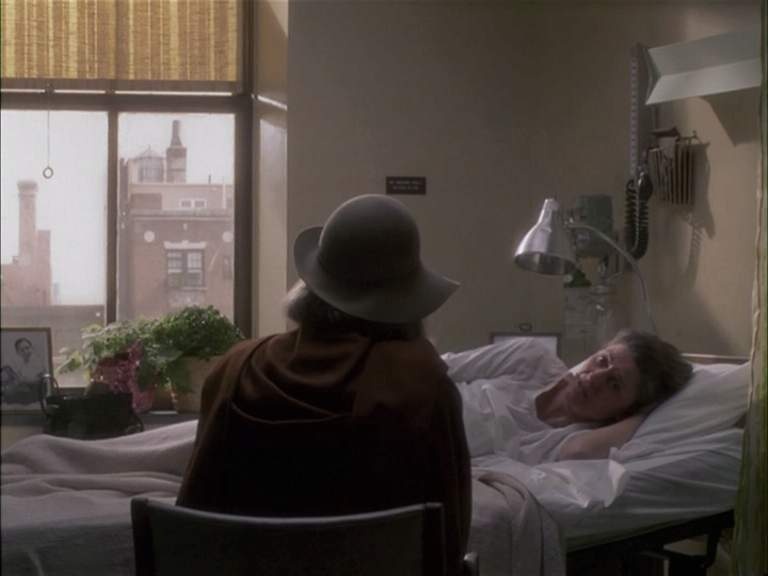
(1984), C, Director: Sidney Lumet. With Anne Bancroft, Ron Silver, Catherine Hicks, Carrie Fisher, Howard Da Silva, Hermione Gingold. 104 min. PG-13. Hi-Fi, CBS/Fox, $79.98. Three stars.
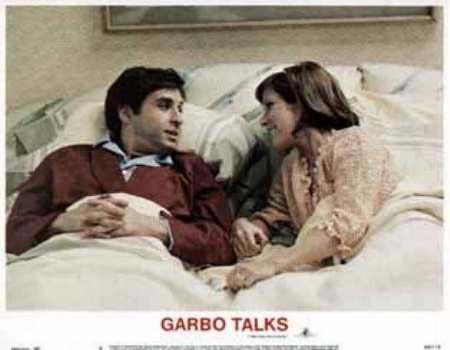
Perhaps the most delightful single aspect of thus warm, contemporary New York comedy is the degree to which it suggests anything but a movie of the present. From the animated cartoon behind the opening credits to the winsome conclusion in central Park, Garbo Talks registers more like a Hollywood film of the sixties or seventies than an expression of today’s sensibilities. (Where’s Poppa?, an absurdist comedy of 1970, provides a useful cross-reference.) The fact that scriptwriter Larry Grusin and director Sidney Lumet both seem perfectly aware of this adds a tang of irony to the film’s pleasure. They know, as we do, that lovable, eccentric radical like Estelle Rolfe (Anne Bancroft), who would have seemed almost commonplace in a movie 10 or 15 years ago, comes across as an audacious concept in the mid-eighties.
The plot of Garbo Talks is built around Estelle, and the role fits Anne Bancroft like a glove. The movie manages to milk the maximum out of her performance — one of the best in her impressive career — without keeping her onscreen any longer than is absolutely necessary. Read more
From Film Comment, November-December 1992. I’m not sure which of the stills directly below is printed backwards, so I’m including both of them.– J.R.


My 13th year at the Toronto Festival of Festivals reconfirmed my feeling that it’s large enough to satisfy many disparate and even contradictory viewing agendas. But even with a reported 320 films this year, it can’t be said to accommodate every taste. That is, one can generally count these days on the festival showing every new film by Paul Cox, Manoel de Oliveira, Henry Jaglom, Stanley Kwan, and Monika Treut, but not every new feature by Jean-Luc Godard, Jean-Pierre Gorin, Raul Ruiz, or Trinh T. Minh-ha (whose latest offerings were all absent this year) — or any work at all by Jean-Marie Straub and Danièle Huillet, Harun Farocki, or Leslie Thornton. Certain thresholds are maintained regarding difficulty, and while Toronto audiences are possibly the most polite and appreciative that I know of anywhere, the programmers don’t seem eager to test their limits. After the screening of his delightful and significantly titled Careful, Winnipeg weirdo Guy Maddin pointedly observed that if a Canadian sees a great movie, he or she says it’s pretty good, and if a Canadian sees a terrible movie, he or she says it’s pretty good. Read more
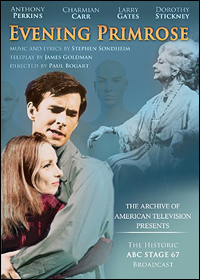
An extremely odd 1966 Steven Sondheim TV musical (1966) — 52 minutes, in black and white — adapted by James Goldman from an equally odd john Collier story of the same title about a poet (Anthony Perkins) who decides to live in a Manhattan department store and discovers an entire community of after-hours eccentrics already camped out there, including a wispy maiden (Charmian Carr) who’s spent most of her life there, whom he falls in love with and teaches how to read. Perkins, by the way, is a pretty delightful singer. The fact that part of this show was actually shot on location in and around a 42nd Street emporium is only part of what’s so strange about it. But I find it impossible to guess how peculiar it might have looked 44 years ago, because I’ve just seen it for the first time.
A good-quality, newly discovered kinoscope print of this ABC Stage 67 broadcast is what led to this recent DVD release. Among the useful and thoughtful extras is an extended interview with the now-retired director, Paul Bogart — a TV veteran who also directed Torch Song Trilogy back in 1988, and who offers a thoughtful autocritique, at once modest and apt, of his own contributions. Read more
From the Chicago Reader (May 13, 1988). — J.R.
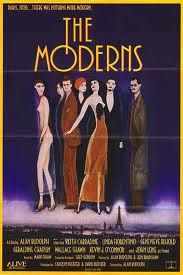
THE MODERNS
*** (A must-see)
Directed by Alan Rudolph
Written by Rudolph and Jon Bradshaw
With Keith Carradine, Linda Fiorentino, Geneviève Bujold, Geraldine Chaplin, Wallace Shawn, Kevin J. O’Connor, and John Lone.
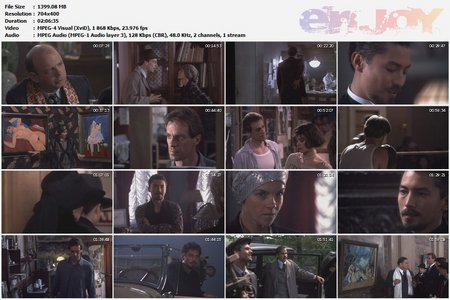
For its first hour, at least, The Moderns gives us an Alan Rudolph very nearly back at the top of his form, on a level that approaches that of his two masterpieces, Remember My Name and Choose Me. The effort isn’t sustained — and the movie encounters a number of booby traps, emerging more than a little battle scarred — but it still qualifies as far and away the most ambitious Rudolph movie to date. Painters and art critics who were offended by the treatment of art forgery in Orson Welles’s F for Fake will probably be even more outraged by Rudolph’s tracing of related ironies, set in what purports to be the Paris of 1926. But those who are will be missing something enjoyable.
Fundamentally a gifted stylist with only a couple of effective stories to tell — usually “romantic” yarns that progressively unravel their own artificiality, inviting the viewer to reassemble them — Rudolph has had an unusually scattered and elusive career. Read more
From Cineaste, Spring 1996. — J.R.

A dozen years ago, when his second feature, Stranger Than Paradise, catapulted him to worldwide fame, Jim Jarmusch seemed at the height of arthouse fashion. Having already known him a little before then, I could tell that the extent to which he suddenly became a figurehead for the American independent cinema bemused him in certain ways. Given the aura of hip, glamorous downtown Manhattan culture that seemed to follow him everywhere, how could it not? I can still recall a New York Times profile a few years back that was so entranced by his image that it suggested that, simply because Jarmusch chose to live in the Bowery, that neighborhood automatically took on magical, transcendent properties.
When Dead Man, his sixth feature, premiered at Cannes last year, it suddenly became apparent that Jarmusch’s honeymoon with the American press was over — although his international reputation to all appearances survives intact. There are multiple reasons for this, including Dead Man itself, and before getting around to this visionary, disturbing black-and-white Western — which I regard as his most impressive achievement to date — it’s worth considering what’s happened to the American independent cinema over the past decade, which has a lot to do with Jarmusch’s changed position in the media. Read more
From the March 14, 2003 Chicago Reader. — J.R.
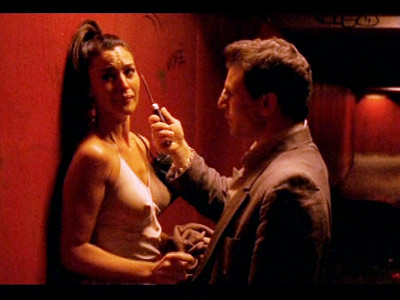

Irreversible
* (Has redeeming facet)
Directed and written by Gaspar Noe
With Monica Bellucci, Vincent Cassel, Albert Dupontel, Jo Prestia, and Philippe Nahon
Amen.
** (Worth seeing)
Directed by Costa-Gavras
Written by Costa-Gavras and Jean-Claude Grumberg
With Ulrich Tukur, Mathieu Kassovitz, Ulrich Muhe, Michel Duchaussoy, and Fontana Ion Caramitru.

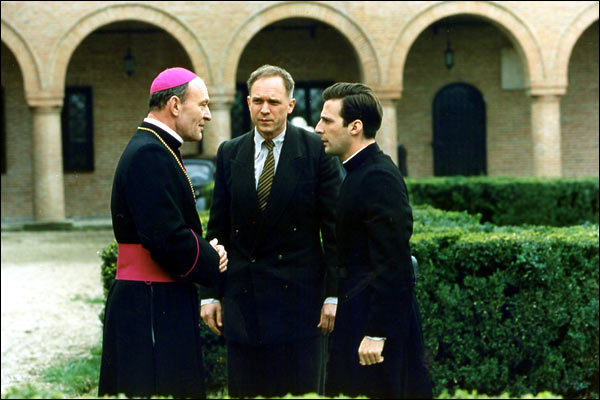
Why link an arty exploitation picture about rape, murder, and revenge with a sober adaptation of Rolf Hochhuth’s The Deputy, a 1960s German play about the failure of the Vatican to save Jewish lives during the Holocaust? One reason is to point out a critical difference between them. In Irreversible Gaspar Noe elects to show us everything — two faces being smashed to bloody messes, the heroine being raped and beaten for an agonizing ten minutes — while in Amen. (which played last week at the Music Box) Costa-Gavras shows his hero Kurt Gerstein (Ulrich Tukur), a newly commissioned SS lieutenant with a conscience, watching the gassing of Jews through a peephole with other officers but refuses to show us any part of what Gerstein sees.
The difference here concerns more than just etiquette. In the terms propounded by Claude Lanzmann’s Shoah (1985), it concerns ethics. Read more
From Video Movies (August 1984). -– J.R.

Out of the Blue
(1981), C. Director: Dennis Hopper. With Linda Manz, Dennis Hopper, Sharon Farrell, and Raymond Burr. 94 min. R. Media, $59.95.
When it was released, a friend wittily and succinctly described Out of the Blue as “Dennis Hopper’s Ordinary People.” Though this film didn’t start out as a Hopper movie (he signed on as an actor and took over direction after shooting started), it certainly has the Hopper flavor: relentlessly raunchy and downbeat, and informed throughout by the kind of generational anguish and sense of doom that characterizes both of his earlier films [Easy Rider and The Last Movie].
Hopper, one should recall, is a figure identified with the 1950s. He made his acting debut alongside James Dean in Nicholas Ray’s Rebel Without a Cause (1955). Conceived as a kind of punk remake of Rebel set in a contemporary working-class environment, Out of the Blue centers around Cindy “CeBe” Barnes (Linda Manz), an alienated 15-year-old punk who perpetually mourns the deaths of Elvis Presley and Johnny Rotten. Her mother, Kathy (Sharon Farrell), is a junkie who works at a cheap restaurant; her father, Don (Hopper), is a former trucker and an alcoholic finishing off a five-year stint in prison when the film opens. Read more
From the Chicago Reader (September 15, 1989). — J.R.

TALES FROM THE GIMLI HOSPITAL
*** (A must-see)
Directed and written by Guy Maddin
With Kyle McCulloch, Michael Gottli, Angela Heck, Margaret-Anne MacLeod, Heather Neale, and Caroline Bonner.

Given the murky black-and-white photography, the fascination with repulsive medical details, the loony deadpan humor, the impoverished characters and settings, and the dreamlike drift of bizarre and affectless incidents, it’s difficult not to compare Tales From the Gimli Hospital with David Lynch’s Eraserhead. It’s also being distributed mainly (although not yet in Chicago) as a midnight attraction by Ben Barenholtz, the same man who launched Eraserhead on the midnight circuits a dozen years ago. Turning up here at the Film Center in Barbara Scharres’s “Films From the Lunatic Fringe” series, Tales From the Gimli Hospital isn’t an easy film to categorize, but invoking the name and weirdness of David Lynch gives you at least a rough idea of what to expect.
In many respects, Guy Maddin’s oddball independent Canadian production is distinctly different from Eraserhead. The sensibility at work here is neither painterly nor musical — the frames aren’t rigorously composed, and the eclectic editing rhythms are relatively stodgy and clunky — but steeped, rather, in the traditions of oral narrative and cinema of the late 20s and early 30s. Read more
From the Chicago Reader (June 1, 1990). — J.R.
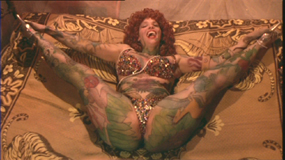
This 1989 feature by Alejandro Jodorowsky is just as silly and pretentious as his previous El topo and The Holy Mountain, but it’s similarly watchable and fun in a campy, sub-Fellini sort of way — if only because of its dogged devotion to surrealist excess. (The Mel Brooks of vulgar surrealism, Jodorowsky’s basic principle is that if you throw 30 outrageous ideas at the audience, 2 or 3 are bound to make an impression.) It’s basically a sadomasochistic circus story about a crazed former magician (played at different ages by Jodorowsky’s sons Axel and Adan) whose father (Guy Stockwell) ran a circus and whose mother (Blanca Guerra) is a religious fanatic who worshiped an armless saint and lost her own arms. Many years after a traumatic (if, for Jodorowsky, characteristic) family incident that involves the mother’s mutilation and the father’s mutilation and suicide, the mother compels her son to become her lost hands, forcing him, among other things, to murder lots of women (Thelma Tixou, Zonia Rangel Mora, Gloriella). A deaf-mute the son loved as a child (Sabrina Dennison and Faviola Elenka Tapia) turns up later to redeem him. Scripted by Jodorowsky, Roberto Leoni, and Claudio Argento, and filmed in Mexico in English. Read more
From American Film (April 1982). — J.R.

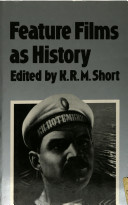
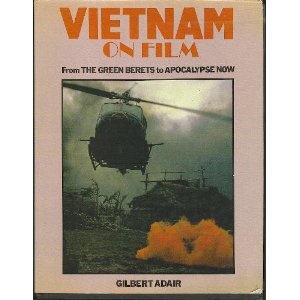
The Film in History: Restaging the Past by Pierre Sorlin. Barnes & Noble, $21.50.
Feature Films as History edited by K.R.M. Short. University of Tennessee Press, $16.50.
Vietnam on Film: From “The Green Berets” to “Apocalypse Now” by Gilbert Adair. Proteus, $13.95.
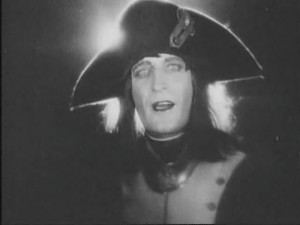
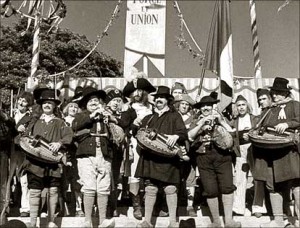
What is a historical film? Sociologist and cultural historian Pierre Sorlin concludes a comparison between two French films about the French Revolution released during the mid-thirties — Abel Gance’ s Napoleon Bonaparte and Jean Renoir’s La Marseillaise — with a succinct formula for his provocative working assumption in The Film in History. “A historical film,” he writes, “is a reconstruction of the social relationship which, using the pretext of the past, reorganizes the present.”
It’s an interesting notion to try out on all the films that we regard as historical. To get a proper fix on Reds, for instance, one has to consider not only the years 1915 to 1920, during which the portrayed events take place, but also the much more immediate past, during which the movie was being formulated and put together, and the present, during which it is being seen and understood. Thus the relatively short shrift paid in the film to class differences – a fundamental issue in John Reed’s life — can be ascribed in part to the basically middle-class orientation of the student revolts in the sixties, which have a lot to do with the way that we currently regard radical politics. Read more
From the Chicago Reader (July 22, 1990). — J.R.

One of the classiest and most experimental 3-D efforts from Hollywood — as well as one of the best MGM musicals of the 1950s that didn’t come from the Arthur Freed unit. Adapted by Dorothy Kingsley from the successful 1948 Cole Porter stage musical and directed by the underrated George Sidney, this 1953 feature does interesting things with mirrors, windows, and the relationship between stage and audience, playing on the differences between theatrical and film space and, paradoxically, exploiting 3-D as an artificial and antirealistic effect. Kathryn Grayson and Howard Keel play an estranged couple who uneasily join forces in a musical version of Shakespeare’s The Taming of the Shrew, with much comic confusion between life and art. The cast (including Ann Miller, Tommy Rall, Bobby Van, Bob Fosse, and Carol Haney) and score are consistently pleasurable. 109 min. (JR)

Read more
Originally published in Moving Image Source (posted online as “Hidden Treasures”), July 17, 2008. — J.R.
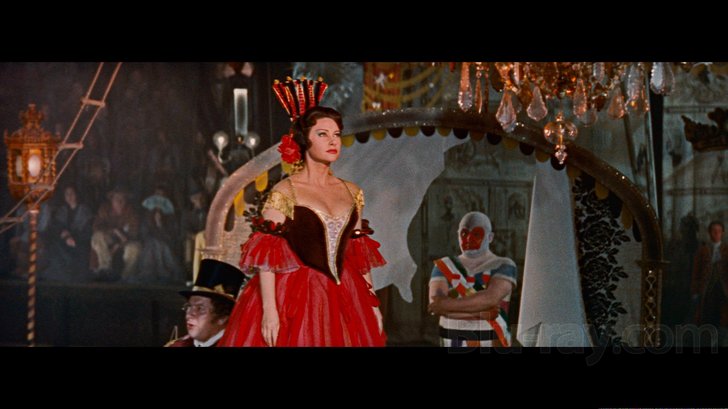
Ever since I retired a few months ago from my 20-year stint as film reviewer for the Chicago Reader, perhaps the biggest perk of all has been freedom from the chore of having to keep up with new movies. In practice, this translates into more free time to keep up with old movies. So returning to one of my favorite annual pastimes, Il Cinema Ritrovato in Bologna — a festival that caters to people devoted to seeing old films in good prints — seemed only natural. Its 22nd edition, the fourth one I’ve attended, was especially rich.
Held in the oldest university town in Europe — hot and muggy this time of year, and full of labyrinthine back streets — the eight-day event mainly takes place at three air-conditioned cinemas during the day and at the Piazza Maggiore every evening, where the grand public shows up for outdoor screenings. (There’s also a jury that I’ve served on in previous years selecting the best restorations on DVD.) Read more
From the Chicago Reader (May 1, 1991). This is available on Blu-Ray from Twilight Time. — J.R.
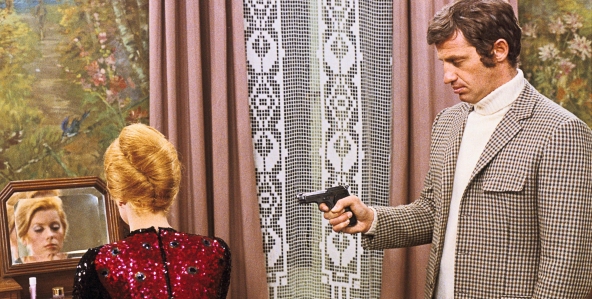
Francois Truffaut’s free adaptation of Cornell Woolrich’s masochistically doom-ridden Waltz Into Darkness, in ‘Scope and color, yields an unsuccessful but sympathetic exploration of the filmmaker’s underrated darker side. A wealthy tobacco planter (Jean-Paul Belmondo) sends for a mail-order bride, and the mysterious lady who turns up is not the woman he was led to expect but Catherine Deneuve. Stately and languorous in its dreamy melancholy, though never entirely convincing, this 1969 picture is full of movie references — even the cabin at the end of Truffaut’s own Shoot the Piano Player figures centrally. But perhaps its ultimate justification is that of Truffaut’s other morbid films, such as The Bride Wore Black, The Story of Adele H, and The Green Room: a doomed romantic protagonist (in this case Belmondo) who goes the limit. In French with subtitles. 123 min. (JR)
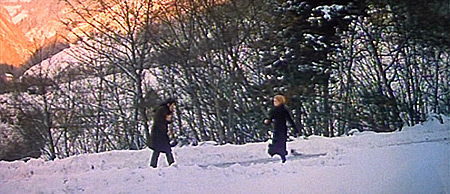
Read more
From the Chicago Reader (May 1999). — J.R.


Not bad for a toy commercial, and the SF settings, however familiar, are even more impressive than the gadgets and beasties. The casualties are narrative momentum (at least compared to episode four) and the actors — Liam Neeson, Ewan McGregor, Natalie Portman, Frank Oz, Samuel L. Jackson, Ray Park — who are stilted and humorless but can’t be blamed, since George Lucas’s mind was on the digital effects. (An overgrown Jamaican reptile of indeterminate gender named Jar Jar Binks has been created specifically to tell the audience when it’s OK to laugh.) At great expense, Lucas has finally succeeded in duplicating his low-budget models (mainly serials and westerns of the 50s) in emotional range as well as in action. The digital effects help him realize this sincere aim, but the campy whiffs of pseudoprofundity are strictly analogical and exclusively the writer-director’s, and in a way they’re every bit as charming as the simplicity. PG, 133 min. (JR)
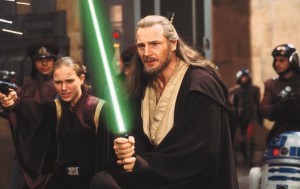
 Read more
Read more
































